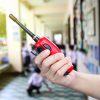Much of the nation’s collective response in dealing with the COVID-19 crisis has centered on public health. Medical personnel have clear guidelines for handling patients who show symptoms of the disease, as well as standard procedures for those who show no symptoms.
But what about our traditional “first responders”? Patrol officers, security officers and campus police officers must be prepared to respond when the other units of the human service system are strained or unable to help.
Consider their many roles: Police patrol officers may contend with complex COVID-19 measures as they administer tactical first aid and CPR. Additionally, they may be called to protect health workers, provide security to health care and testing facilities, and patrol vacated small businesses. They also are likely to serve as a first-line public information source during service calls. When officers come into contact with the public, it is critical that they have the most accurate COVID-19 information to refer the public to health services and other agencies.
Sheldon Greenberg, Johns Hopkins School of Education professor and a former patrol officer for the Howard County Police Department, has identified these concerns in routine conversations with former students who are frontline police officers and leaders. In response, he has developed COVID-19 guidelines for police patrol officers, security officers, and campus police.
In ways that are often similar to our school systems, United States law enforcement is decentralized, operating primarily through local governmental police agencies—17,985 of them across the country. The rapidly deteriorating COVID-19 pandemic has made dissemination of accurate and specific COVID-19 information for the law enforcement community a priority—and a challenge. The most recent Centers for Disease Control and Prevention (CDC) guidelines do not provide specific protection measures for frontline patrol officers, Sheldon says.
In response, Greenberg’s guidelines cover a myriad considerations, including personal protection measures— such as disinfecting the officer’s duty belt, vehicle, and protective wear; incorporating information about COVID-19 contacts in incident reports; preparing patrol vehicles with protection and sanitation equipment; developing quarantine protocols; and considerations when protecting medical facilities and hospitals.
The COVID-19 Guidelines for Police Patrol Officers and Campus Police and Security Officers is based, in part, on Greenberg’s prior research for Frontline Policing in the 21st Century: Mastery of Police Patrol, Palgrave Macmillan, 2017. The guidelines were reviewed by the International Association of Chiefs of Police and the International Association of Campus Law Enforcement Administrators. Dissemination of the guidelines occurs through the U.S. Department of Justice, police organizations, and the CDC.
Greenberg, an associate dean at the School of Education for more than a decade, today serves the director for school security and technology at the Center for Safe and Healthy Schools. He has served on national commissions and task forces on violence in schools, race-based profiling, police response to people with mental illness, and other many other issues.

